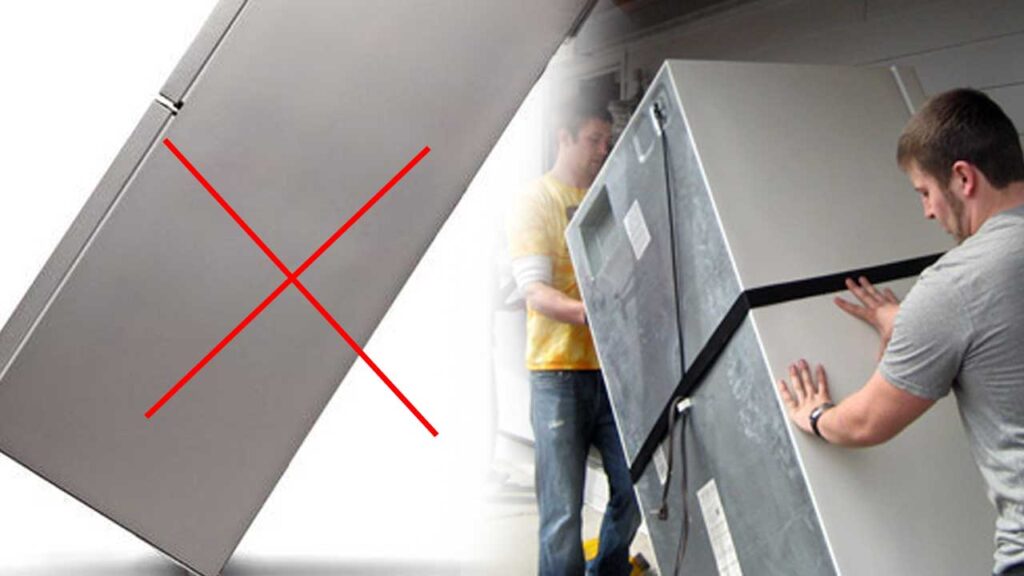If you need to move or transport your refrigerator, you may wonder if you can lay it on its back. While this may seem like a convenient way to fit your fridge in a vehicle or a narrow space, it can also cause some problems for your appliance. In this article, you will learn:
- Why laying a refrigerator on its back is not recommended?
- How long can a refrigerator lay on its back without damage
- What to do before and after laying a refrigerator on its back
- How to transport a refrigerator safely and correctly?
Why Laying a Refrigerator on Its Back Is Not Recommended?
Laying a refrigerator on its back is not recommended because it can damage the compressor and the cooling system. The compressor is the heart of the refrigerator that pumps the refrigerant gas through the coils. The refrigerant gas is what keeps your food cold and fresh.
The compressor contains oil that lubricates and cools its parts. When you lay a refrigerator on its back, the oil can leak out of the compressor and travel to the cooling coils. The oil can clog the coils and prevent the refrigerant gas from flowing properly. This can affect the cooling performance of your fridge and cause it to overheat.
Moreover, laying a refrigerator on its back can also damage the internal parts of the appliance. The parts may shift or get dislodged due to gravity and pressure. This can cause noises, vibrations, or leaks when you turn on your fridge.
How Long Can a Refrigerator Lay on Its Back Without Damage
If you have no choice but to lay your refrigerator on its back, you should do it for as short as possible. Ideally, you should not lay your refrigerator on its back for more than 15 to 20 minutes. This will minimize the risk of oil leakage and damage to the compressor and the cooling system.
However, some sources suggest that you can lay your refrigerator on its back for up to a few hours without causing serious damage. This may depend on the type, model, and age of your fridge. Some newer and smaller fridges may be more resilient and tolerant than older and larger ones.
In any case, you should always check the manufacturer’s manual or website for specific instructions and recommendations for your fridge model. Some fridges may have special features or components that make them more sensitive or prone to damage when laid on their back.
What to Do Before and After Laying a Refrigerator on Its Back
If you need to lay your refrigerator on its back, there are some steps you should take before and after doing so. These steps will help you protect your fridge from damage and ensure that it works properly after moving it.
Before laying your refrigerator on its back, you should:
- Unplug your fridge and let it defrost for at least 24 hours. This will prevent ice buildup and water leakage.
- Remove all the food and drinks from your fridge and store them in coolers or other containers.
- Remove all the removable parts from your fridge, such as shelves, drawers, bins, ice makers, etc. Pack them separately in boxes or bags.
- Secure the doors of your fridge with tape or straps to prevent them from opening during transport.
- Wrap your fridge with blankets or bubble wrap to protect it from scratches and dents.
- Use a dolly or a hand truck to move your fridge carefully and slowly. Avoid tilting or shaking your fridge too much.
After laying your refrigerator on its back, you should:
- Set your fridge upright as soon as possible. Do not turn it on right away.
- Let your fridge rest upright for at least 4 hours (or up to 24 hours) before plugging it in. This will allow the oil to drain back into the compressor and the parts to settle into place.
- Check your fridge for any signs of damage, such as leaks, noises, or smells. If you notice anything unusual, contact a professional technician for assistance.
- Plug in your fridge and let it run for a few hours before putting any food or drinks inside. Make sure that the temperature is stable and consistent.
- Enjoy your freshly moved fridge!
How to Transport a Refrigerator Safely and Correctly?
The best way to transport a refrigerator is to keep it upright at all times. This will prevent any oil leakage, damage, or performance issues. Here are some tips on how to transport a refrigerator safely and correctly:
- Use a vehicle that is large enough to fit your fridge upright. You may need a truck, a van, or a trailer for this purpose.
- Secure your fridge with ropes or straps to prevent it from sliding or falling during transport. Make sure that there is enough space around your fridge for ventilation.
- Drive carefully and avoid sudden stops, turns, or bumps. This will reduce the stress and impact on your fridge.
- If possible, hire professional movers or helpers to assist you with moving your fridge. They will have the experience and equipment to handle your fridge safely and efficiently.
Laying a refrigerator on its back is not a good idea, as it can cause damage to the compressor and the cooling system. However, if you have no other option, you can lay your fridge on its back for a short period of time, as long as you follow the proper steps before and after doing so.
The best way to transport a refrigerator is to keep it upright and secure it well. By following these tips, you can move your fridge without any problems and enjoy its cooling benefits for years to come.







